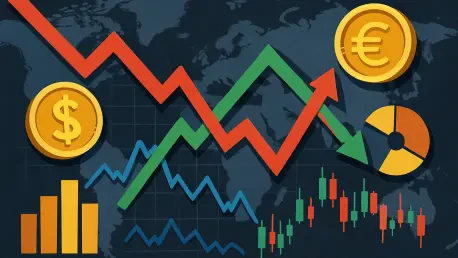In the ever-evolving arena of global finance, markets are currently caught in a turbulent storm of uncertainty, characterized by what financial analysts describe as “looping narratives”—recurring and often contradictory stories that trigger swift and dramatic shifts in investor sentiment. These narratives, ranging from geopolitical skirmishes to unexpected policy reversals, have created a landscape where stability feels like a distant memory. The volatility is palpable as traders and investors navigate a maze of conflicting signals, with each news cycle potentially upending carefully crafted strategies. From sharp market drops to tentative recoveries, the financial world is on edge, reacting to every headline with heightened sensitivity. This intricate web of events, encompassing trade disputes, political developments, and economic indicators, demands a closer examination to understand how these looping narratives are shaping market behavior and what they mean for the future of global economies.
Geopolitical Tensions and Market Volatility
U.S.-China Trade Disputes
The ongoing trade friction between the United States and China stands as a prime example of how geopolitical tensions fuel market instability. Recent threats of steep tariffs from the U.S. administration, followed by a sudden pivot to more conciliatory language, have sent shockwaves through financial hubs. Such erratic messaging led to a significant plunge in major indices like the S&P 500, with losses marking some of the worst weekly performances in months, only for futures to rebound slightly as hopes for a tariff truce surfaced. The uncertainty surrounding the renewal of critical bilateral trade agreements adds another layer of complexity, keeping investors in a state of constant alertness. With potential summits on the horizon and communication between trade representatives stalling, the market remains vulnerable to sudden shifts driven by the smallest policy hint or diplomatic gesture.
Beyond the immediate market reactions, the broader implications of this trade standoff are becoming increasingly evident in global economic alignments. China’s export data reveals a strategic pivot, showing robust growth in trade with regions like the European Union, Southeast Asia, and Africa, even as exports to the U.S. sharply decline. This diversification suggests a deliberate effort to reduce reliance on American markets amid persistent tensions. For investors, this shift raises questions about long-term supply chain stability and the potential reconfiguration of global trade networks. The unpredictability of U.S.-China relations continues to be a dominant force, with each statement or policy move acting as a catalyst for either panic or cautious optimism among market participants worldwide.
Supply Chain Vulnerabilities
Another critical dimension of geopolitical tension lies in the vulnerability of global supply chains, particularly due to China’s near-monopoly on rare earth elements essential for high-growth industries. These materials are indispensable for sectors such as artificial intelligence, electric vehicles, and defense technologies, making any disruption a significant threat to economic stability. The possibility of export curbs or escalated trade conflicts could choke supply lines, leading to production halts and price surges in tech-heavy markets. This strategic control over rare earths places China in a powerful position, amplifying fears of targeted restrictions as a retaliatory measure in trade disputes, which could ripple across global markets with devastating effect.
Moreover, the reliance on these critical resources exposes sector-specific risks that investors must now factor into their strategies. Companies in technology and green energy, already navigating a complex landscape of innovation and competition, face heightened uncertainty as geopolitical tensions loom large. The potential for sudden policy shifts to disrupt access to rare earths underscores a broader fragility in the interconnected global economy. As markets react to each development in the U.S.-China saga, the specter of supply chain interruptions serves as a stark reminder of how deeply entwined geopolitical maneuvers are with financial outcomes, pushing firms and investors to seek alternative sources or contingency plans to mitigate risks.
Economic Concerns and Valuation Risks
Overvaluation Warnings
Amid the geopolitical turbulence, a growing chorus of financial leaders has raised alarms over the apparent overvaluation of equity markets, pointing to a troubling disconnect between current stock prices and the underlying economic realities. Prominent figures at international financial gatherings have warned that the lofty multiples seen in major indices may not be sustainable given the uncertain geopolitical and economic outlook. This concern is particularly acute as markets have been buoyed by optimism in certain sectors, despite persistent risks that could trigger a sharp correction. Such warnings highlight the fragility of investor confidence, with the potential for a sudden shift in sentiment to erase gains accumulated over months in mere days.
The implications of these overvaluation concerns extend beyond mere cautionary tales, as they influence how investors approach risk in an already volatile environment. Historical patterns suggest that periods of overextended valuations often precede significant market adjustments, especially when coupled with external shocks like geopolitical crises or disappointing economic data. For global markets, the current scenario presents a delicate balancing act—maintaining momentum while bracing for potential downturns. As financial leaders continue to sound the alarm, the focus shifts to upcoming economic indicators and corporate performance metrics that could either validate these high valuations or precipitate a much-feared market pullback.
U.S. Earnings Season as a Litmus Test
As the U.S. corporate earnings season approaches, it emerges as a critical juncture for assessing whether current market valuations hold water. With major financial institutions set to release their quarterly results, investors are keenly focused on whether projected earnings growth—estimated at nearly 9% year-on-year for the S&P 500—can justify the elevated stock prices. Strong performances from key players in the banking sector could provide a much-needed boost to market confidence, reinforcing the narrative of economic resilience. However, any shortfall in these results risks deepening existing fears of overvaluation, potentially triggering a broader sell-off as investors reassess their positions in light of weaker-than-expected data.
The stakes of this earnings season extend beyond individual company performances to the broader market psyche, serving as a barometer for economic health amid looping narratives. Analysts anticipate that sectors sensitive to interest rates and consumer spending will offer crucial insights into the impact of recent policy shifts and trade tensions. A positive earnings outcome could temporarily stabilize markets, offering a counterpoint to the prevailing uncertainty, while disappointing figures might amplify concerns about systemic risks. As these reports unfold, they will likely shape not only short-term market movements but also long-term investor strategies, highlighting the pivotal role of corporate performance in navigating the current financial landscape.
Political and Policy Influences
European Political Stability
In Europe, recent political developments have offered a semblance of stability, particularly with the reappointment of France’s Prime Minister, signaling continuity in leadership amid a challenging political climate. This move has provided a slight reprieve for European equity markets, which have shown signs of steadying after recent sell-offs. However, beneath this surface calm lie persistent challenges, including a fragmented parliament and looming difficulties in crafting budgets for the coming years, such as those planned through 2027. These underlying issues keep market participants cautious, as the potential for policy gridlock or unexpected political shifts could easily reignite volatility across the region.
Furthermore, the broader European context remains fraught with risks that could impact financial markets beyond national borders. Concerns over energy infrastructure vulnerabilities and geopolitical frictions add to the uncertainty, especially as winter approaches and energy demands rise. While the immediate political landscape in France offers a momentary buffer, the interconnected nature of European economies means that any significant disruption could have a cascading effect. Investors are thus keeping a close watch on how these political dynamics evolve, recognizing that stability in one nation does not guarantee immunity from broader regional or global shocks that continue to test market resilience.
Federal Reserve’s Role
The Federal Reserve’s upcoming policy statements are poised to play a significant role in shaping market expectations, particularly as inflationary pressures mount due to recent trade tariffs. With Fed Chair Jerome Powell scheduled to speak at key international meetings, investors are eager for clarity on how monetary policy might address the complex interplay of inflation and economic growth. The burden of tariffs, which early data suggests is largely borne by U.S. consumers and businesses, adds another layer of difficulty to the Fed’s balancing act, as it seeks to curb price rises without stifling economic momentum. These statements could either soothe or unsettle markets, depending on the signaled direction of interest rates and inflation control measures.
Additionally, the Fed’s response to these challenges will likely influence global financial sentiment, given the dollar’s role as a cornerstone of international trade and investment. Markets are particularly sensitive to any indication of tightening or easing policies, which could ripple through currency valuations and bond yields worldwide. The complexity of managing inflation amid trade-driven cost increases places the Federal Reserve under intense scrutiny, as its decisions will not only impact domestic markets but also set the tone for how other central banks react. As anticipation builds, the Fed’s guidance is seen as a critical factor in either stabilizing or further complicating the already volatile global market environment.
The Nature of Looping Narratives
Rapid Sentiment Shifts
At the heart of the current market turmoil lies the phenomenon of rapid sentiment shifts, driven by the relentless pace of looping narratives that dominate financial news cycles. A single tweet, policy reversal, or economic report can pivot investor behavior overnight, creating a whipsaw effect that makes predicting market movements extraordinarily difficult. This dynamic was evident in the swift market drops following aggressive trade rhetoric, only for sentiment to partially recover on hints of diplomatic softening. Such volatility underscores how interconnected and reactive global markets have become, with each piece of information amplified through digital channels, leaving little room for measured responses or long-term planning.
The challenge for market participants lies in adapting to this environment where narratives loop back on themselves, often presenting contradictory signals within days or even hours. This rapid cycling of news and opinion fuels uncertainty, as investors struggle to discern which developments hold lasting significance and which are mere noise. The speed at which sentiment shifts also complicates risk management, as traditional models may fail to account for the emotional and psychological drivers behind these movements. In this climate, staying informed and agile becomes paramount, as markets remain susceptible to the smallest trigger that could alter the trajectory of investor confidence.
Navigating Market Whiplash
Navigating the whiplash induced by these looping narratives presents a formidable challenge for investors and financial strategists alike. The constant barrage of geopolitical updates, economic data releases, and policy changes demands a high degree of adaptability, as strategies that worked one day may be obsolete the next. Building resilience against this backdrop involves diversifying portfolios to mitigate risks from sudden market swings and maintaining a keen awareness of global events that could influence financial outcomes. The ability to quickly interpret and react to new information is crucial, as delays in response can result in significant losses during periods of heightened volatility.
Looking back, the market’s journey through these turbulent times reflected a persistent struggle to find footing amid ever-shifting narratives. The interplay of trade disputes, political developments, and economic indicators created a complex puzzle that tested the mettle of even the most seasoned investors. Moving forward, the focus should shift to developing robust frameworks for anticipating potential triggers of volatility, such as geopolitical flashpoints or key economic reports. Enhancing analytical tools to better predict sentiment shifts and fostering international cooperation to stabilize trade relations could offer pathways to smoother market conditions. As the financial landscape continues to evolve, proactive measures and strategic foresight will be essential in turning the challenges of looping narratives into opportunities for growth and stability.









